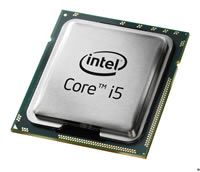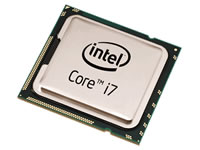Difference between Intel i5 and i7
Key difference: Intel’s latest microprocessors are Intel Core i5 and Intel Core i7. Both i5 and i7 have various different microprocessors under the brand, and each processor varies from one another as much as from processors under the other brand. Processors under the i5 brand are meant to be a mid-level offering. They tend to have 2 to 4 cores. i7, on the other hand, is more of a high end offering aimed mainly at professionals and programmers. Processors under the i7 brand have 4 to 7 cores.
 A dual-core processor is a type of a central processing unit (CPU) that has two complete execution cores. Hence, it has the combined power of two processors, their caches and the cache controllers onto a single chip. This makes the dual-core processors well-suited for multitasking. While, a quad-core processor has four cores. Hence, quad-core processors are twice as effective as a dual-core.
A dual-core processor is a type of a central processing unit (CPU) that has two complete execution cores. Hence, it has the combined power of two processors, their caches and the cache controllers onto a single chip. This makes the dual-core processors well-suited for multitasking. While, a quad-core processor has four cores. Hence, quad-core processors are twice as effective as a dual-core.
Both, dual and quad processors fall under multiple-core processors, which is basically any processor that has 2 or more processors. Currently, multiple-core processors in the market can range from 2 to 6 cores.
Intel Corporation is a multinational semiconductor chip maker corporation headquartered in Santa Clara, California. It is actually the inventor of the x86 series of microprocessors. Currently, Intel is the world's largest and highest valued semiconductor chip maker, based on revenue.
Intel’s latest microprocessors are Intel Core i5 and Intel Core i7. Both i5 and i7 have various different microprocessors under the brand, and each processor varies from one another as much as from processors under the other brand. Processors under the i5 brand are meant to be a mid-level offering. They tend to have 2 to 4 cores. i7, on the other hand, is more of a high end offering aimed mainly at professionals and programmers. Processors under the i7 brand have 4 to 7 cores.
The main difference that sets i5 and i7 apart from the other processors is that the latest generation of i5 and i7 processors has a 22nm architecture. This is in comparison to the 45nm architecture which was the previous norm. Even the i5 and i7 processors were first launched with 45nm architecture but the subsequent generations of the processor have declined overtime to 22nm architecture. The smaller width of the chip allows more transistors within the same silicon chip.
The size of the processors allows for the integration of the Direct Media Interface (DMI) and the Graphics Processing Unit (GPU) within the chip. The GPU makes the processor perform better and more uniformly on different motherboard brands. The DMI, on the other hand, shortens the electrical path between the core and the actual components like the RAM, hard drives, ports, and other resources.
This sets them apart from previous processors. This also allows the i5 and i7 to consume less power, which leads to less heat generation, in addition to better and faster performance. The lower power consumption is especially a plus in laptops, as it increases battery life.
As oppose to the previous multi core processors, both i5 and i7 also support Hyper-Threading Technology. Hyper-threading duplicates certain sections of the processor that store the architectural state but not duplicating the main execution resources. This allows the processor to appear as two processors, hence effectively scheduling two threads or processes simultaneously. The 3rd generation of i5 processors hosts 4 threads, while i7 processors host from 4 to 8 threads.
 The i5 and i7 processor both have turbo boost. Turbo boost is a technology that allows the processor to overclock beyond its typical speed. This only happens when the operating system needs it to, the rest of the time the processors runs at its normal speed. The overclocking is only limited by the power and heat dissipation limits of the processor. The overclocking is extremely useful as it increases the computing power of the operating system. The design concept behind Turbo Boost is also commonly referred to as "dynamic overclocking".
The i5 and i7 processor both have turbo boost. Turbo boost is a technology that allows the processor to overclock beyond its typical speed. This only happens when the operating system needs it to, the rest of the time the processors runs at its normal speed. The overclocking is only limited by the power and heat dissipation limits of the processor. The overclocking is extremely useful as it increases the computing power of the operating system. The design concept behind Turbo Boost is also commonly referred to as "dynamic overclocking".
Furthermore, all i5 processors have cache memory between 3MB to 6MB, while the cache memory of the i7 processor ranges between 4MB to 8MB. Cache memory is important because it is much faster compared to RAM. A higher cache memory means that the processor accesses the slower RAM much less often.
In comparison, the i7 processors are of course better and faster than the i5 processors, and hence are also more expensive. The i7 processors have more capabilities for multi-tasking, multimedia tasks, high end gaming, and scientific work. However, the difference between high end i5 processors and low end i7 processors is minimal.
Also these differences would not matter or rather should not matter to the general public, as the i5 is more than sufficient for daily use, including web-surfing, gaming, music, photos and video editing, etc., generally what most people use a computer for. The i7 processors, on the other hand, are aimed at high end users and heavy users. These are the one who are often programming, or do high end video and photo editing, etc. This mainly includes programmers, graphic designers, animators, etc.
A general comparison between the two processors as per the Intel website:
|
|
Intel Core i5 |
Intel Core i7 |
|
Intel Smart Cache |
3 – 6 MB |
4 – 8 MB |
|
Intel Turbo Boost Technology |
Yes |
Yes |
|
Intel Hyper-Threading Technology |
Yes |
Yes |
|
# of Cores |
2 – 4 |
4 – 7 |
|
# of Threads |
4 |
4 – 8 |
|
Silicon |
22nm – 45nm |
22nm – 45nm |
|
Clock Speed |
1.7 – 3.4 GHz |
2.53 – 3.6 GHz |
Image Courtesy: xsreviews.co.uk, crazyengineers.com









Add new comment